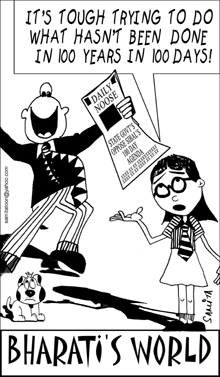A pall of fear and loathing hangs over academia in the eastern seaboard state of West Bengal (pop. 80 million), which has been governed by the Communist Party of India-Marxist (CPM)-led Left Front government since 1977. On June 19, state higher education minister Sudarshan Raichaudhuri announced that his ministry is setting up an inspectorate to check “what’s being done and what’s not being done in colleges and universities” across the state. Academics in the state have acquired sufficient experience of the CPM modus operandi to expect quasi-literate party commissars and cadres to sit in judgement over them. Hence the cloud of trepidation and anxiety which has descended upon the state’s 37 government colleges, 146 private self-financing and 397 government-aided colleges, and 18 autonomous universities.
 Raichaudhuri confirms that party apparatchiks who will dominate the inspectorate will be given wide powers. “It will look into various issues such as classes being held regularly, students attending class lectures, problems faced by college authorities, and whether and how the problems are being addressed,” says Raichaudhuri, who glosses over the fact that an education directorate headed by a director with ex-officio rank of secretary, and the mandate to supervise higher education, already exists within the higher education ministry.
Raichaudhuri confirms that party apparatchiks who will dominate the inspectorate will be given wide powers. “It will look into various issues such as classes being held regularly, students attending class lectures, problems faced by college authorities, and whether and how the problems are being addressed,” says Raichaudhuri, who glosses over the fact that an education directorate headed by a director with ex-officio rank of secretary, and the mandate to supervise higher education, already exists within the higher education ministry.
Quite obviously the Left Front government feels that the education directorate is not up to the job, and a new inspectorate is required. The state’s Harvard-educated finance minister Asim Dasgupta grandly declared as much in his budget speech to the legislative assembly on March 23. “It has been decided to attach special importance to improvement in the standard of higher education through an appropriate inspection mechanism,” he said.
The out-of-the-blue announcement of the beleaguered Left Front government — which is split over the issue of violently neutralising the CPI (Maoist) which has unleashed an armed revolution in the CPM stronghold of Lalgarh, or “re-educating” its leaders — to establish an inspectorate for higher education indicates that under the past three decades of Communist rule, standards in institutions of higher education — packed with party faithfuls and cadres — have slipped badly. Nevertheless, in the Left Front government’s education budget of Rs.11,967 crore for 2009-10, the provision for higher education is a mere Rs.149 crore (Rs.118.5 crore in 2008-09), 80 percent of which will be consumed by way of faculty pay and perks. The plan (capex) outlay for higher education is also a miserly Rs.149 crore, to be spread over 87 government and 397 aided colleges.
Despite negligible investment in additional capacity creation, in consonance with the Marxist dogma of tight government control of higher education, the state government is silent on the issue of inviting private investment in higher education. “I fail to understand why private investment is encouraged by the state government in industry, but not in education where it’s urgently required to expand intake capacity. Frankly, I don’t know the answer,” says Dr. A.R. Thakur, vice chancellor of the West Bengal State University.
With the pressure for admission into West Bengal’s much-too-few colleges and universities mounting, and a new wave of inspector raj in the offing, it’s hardly surprising that the mood in the state’s institutions of higher education is sombre, if not downright gloomy.
Sujoy Gupta (Kolkata)